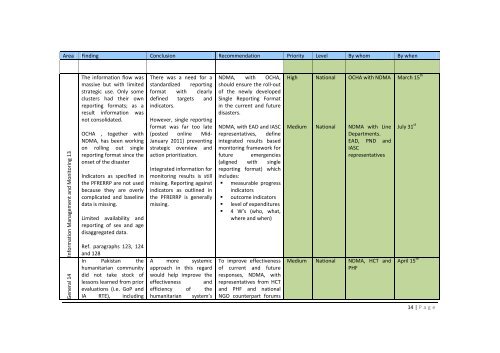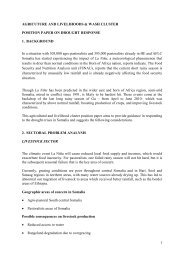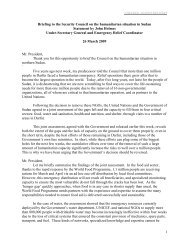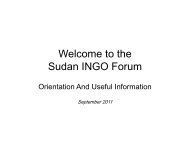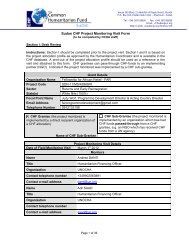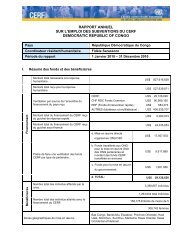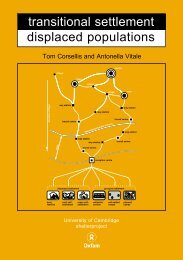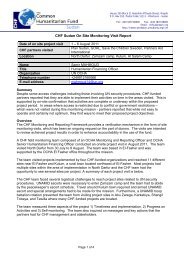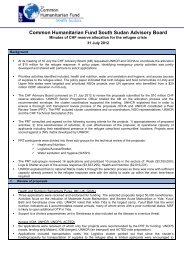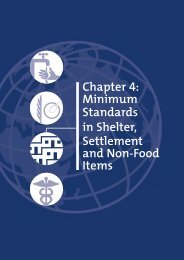Inter-Agency Real Time Evaluation of the Humanitarian ... - OCHANet
Inter-Agency Real Time Evaluation of the Humanitarian ... - OCHANet
Inter-Agency Real Time Evaluation of the Humanitarian ... - OCHANet
Create successful ePaper yourself
Turn your PDF publications into a flip-book with our unique Google optimized e-Paper software.
Area Finding Conclusion Recommendation Priority Level By whom By when<br />
Information Management and Monitoring 13<br />
General 14<br />
The information flow was<br />
massive but with limited<br />
strategic use. Only some<br />
clusters had <strong>the</strong>ir own<br />
reporting formats; as a<br />
result information was<br />
not consolidated.<br />
OCHA , toge<strong>the</strong>r with<br />
NDMA, has been working<br />
on rolling out single<br />
reporting format since <strong>the</strong><br />
onset <strong>of</strong> <strong>the</strong> disaster<br />
Indicators as specified in<br />
<strong>the</strong> PFRERRP are not used<br />
because <strong>the</strong>y are overly<br />
complicated and baseline<br />
data is missing.<br />
Limited availability and<br />
reporting <strong>of</strong> sex and age<br />
disaggregated data.<br />
Ref. paragraphs 123, 124<br />
and 128<br />
In Pakistan <strong>the</strong><br />
humanitarian community<br />
did not take stock <strong>of</strong><br />
lessons learned from prior<br />
evaluations (i.e. GoP and<br />
IA RTE), including<br />
There was a need for a<br />
standardized reporting<br />
format with clearly<br />
defined targets and<br />
indicators.<br />
However, single reporting<br />
format was far too late<br />
(posted online Mid‐<br />
January 2011) preventing<br />
strategic overview and<br />
action prioritization.<br />
Integrated information for<br />
monitoring results is still<br />
missing. Reporting against<br />
indicators as outlined in<br />
<strong>the</strong> PFRERRP is generally<br />
missing.<br />
A more systemic<br />
approach in this regard<br />
would help improve <strong>the</strong><br />
effectiveness and<br />
efficiency <strong>of</strong> <strong>the</strong><br />
humanitarian system’s<br />
NDMA, with OCHA,<br />
should ensure <strong>the</strong> roll‐out<br />
<strong>of</strong> <strong>the</strong> newly developed<br />
Single Reporting Format<br />
in <strong>the</strong> current and future<br />
disasters.<br />
NDMA, with EAD and IASC<br />
representatives, define<br />
integrated results based<br />
monitoring framework for<br />
future emergencies<br />
(aligned with single<br />
reporting format) which<br />
includes:<br />
� measurable progress<br />
indicators<br />
� outcome indicators<br />
� level <strong>of</strong> expenditures<br />
� 4 W’s (who, what,<br />
where and when)<br />
To improve effectiveness<br />
<strong>of</strong> current and future<br />
responses, NDMA, with<br />
representatives from HCT<br />
and PHF and national<br />
NGO counterpart forums<br />
High<br />
Medium<br />
Medium<br />
National<br />
National<br />
National<br />
OCHA with NDMA<br />
NDMA with Line<br />
Departments.<br />
EAD, PND and<br />
IASC<br />
representatives<br />
NDMA, HCT and<br />
PHF<br />
March 15 th<br />
July 31 st<br />
April 15 th<br />
14 | P age


